I thought I’d share some of the new varieties of tomatoes I’m growing this year, along with some old favorites.
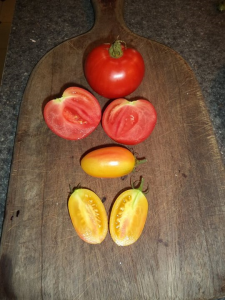
First up is a picture of a new variety from Dr. Harry Klee’s research at the U. of Florida called Garden Gem, along with Blush from Artisan Seeds.
Garden Gem is a new hybrid, poised to take the fresh market grocery store tomatoes on. Same disease resistance, same shipping quality, but with much improved flavor. Dr. Klee describes the research at his site:
The first step in a flavor improvement program starts with a simple question: what do people like and what’s in the varieties that people do like? In order to answer this question, we took a giant step back to “heirloom” tomatoes.
Blush has been around for a few years, an open pollinated variety with a great history of breeding, since 8 year old Alex was instrumental in choosing its parent lines.
The year that the cross that created Blush was made, Alex participated in setting up crosses for our annual winter crossing list. He chose 3 of the 19 crosses to be made that year, after the other 16 had been established (by a PhD-holding plant breeder with big plans). The striking outcome is that about 90% of the value from that year came from Alex’s 3 crosses. The progeny from his crosses continue to permeate most everything we are doing.
Both have something in common in that one of the progenitors for each is a variety called Maglia Rosa.
Note also the meatiness of Garden Gem … I think it will make a great all-purpose variety for the home gardener for canning and sauces, as well as fresh eating.
Another aspect, which you can’t tell very well from the picture of Garden Gem, is the faint yellow striping in the skin, and some later fruits that have a hint of a nipple on the blossom end.
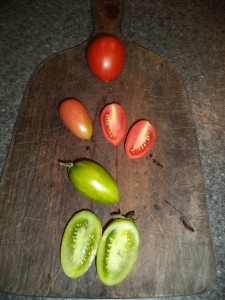
Next up, another Garden Gem, followed by Maglia Rosa, and then Green Tiger. See hints of vestigal “nipple” alluded to earlier in the Garden Gem.
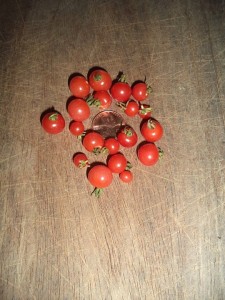
Cute little feller … a Currant Tomato. Actually, a different, but very close relative, and source of much research and study, since it still grows wild in the Andean mountains … PITA to pick, but great “conversation piece” when used as a garnish. Solanum pimpinellifolium
We grew these as part of a variety trial a few years back … more for the novelty. But when we did a Brix test that year, it was the highest recorded.
A little odd, since the flavor is not in the least “sweet” … coulda been just more concentrated. Dunno, really.

Aunt Ruby’s German Green. One of my long term favorites. It’s a more tangy than sweet heirloom variety that stays green when ripe.
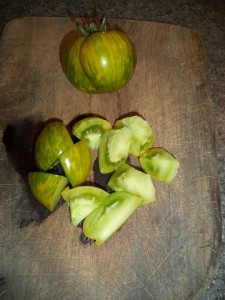
Green Zebra … an open pollinated variety bred by Tom Wagner and introduced in 1983 according to Wikipedia.
Green when ripe, and with yellow striping. Dunno why most of mine this year are exhibiting a lobed shape, rather than perfectly round.
I may have to buy new seeds next year.
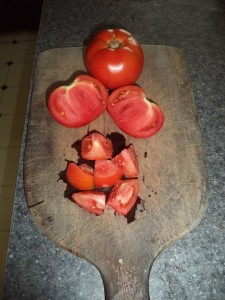
Another hybrid from the research lab of Dr. Harry Klee of the University of Florida. This one is named Garden Treasure.
I don’t have any information about its progenitors, like its companion Garden Gem.
Beautiful, baseball-sized fruit. Very slight indication of green shoulders, and with the same faint yellow stripe as Garden Gem. Also a heavy fruit, very meaty.
And very good flavor. Pretty good balance between tart and sweet. I can see these being popular with fresh market growers.
I sourced the seeds from Dr. Klee’s efforts by making a small donation to his research program at the University of Florida. The idea was brought to my attention by his colleague, Dr. Kevin Folta in this blog post.
We can look forward to new, satisfying varieties that merge the best of production traits with the historical successes that delighted the senses. These are new heirlooms, and they open an exciting peek of what is coming in plant genetic improvement.
Here are more details of the story and the individual varieties! I hope you order some seeds and give your feedback to Dr. Klee so he can build your ideas into the future of tomatoes!
I often complained about the flavorless red things that you find in grocery stores, so here was a way to support researchers working to overcome that.
And Dr. Klee is not alone. Rutgers University went about restoring the old fresh market hybrid varieties that gave “Jersey Tomatoes” their deserved reputation.
Read about Ramapo, Moreton, and a processing tomato at the Rutgers site Rediscovering the Jersey Tomato .
And there are other research programs at Purdue, University of Michigan and Israel conducting similar efforts. No doubt there are others.
The future of good tasting grocery store, and fresh market tomatoes seems bright.
Great info! Wonder if you have any specifics re: disease resistance (particularly Tomato Spotted Wilt Virus)? I did a trial a few years ago in Coastal NC, and Mt. Glory was the only decent tasting variety that indicated resistance.
Our cultivars do not have resistance to Tomato Spotted Wilt Virus. However, Garden Treasure is resistant to gray leaf spot (Stemphyllium), Phytopthera Race 3 and Fusarium wilt Races 0,1 and 2. Garden Gem is resistant to gray leaf spot and Fusarium wilt Races 0, 1 and 2.
Thank you Dr. Klee!
I don’t have any details, but let me get in touch with the research folks at UF and they’ll be in a better position to answer.
Ray, in the last paragraph you refer to tomato researchers at University of Michigan. I think you mean Michigan State, my alma mater, as there are breeders in horticulture at MSU. U of M does not have a horticulture department. Just curious.
It was based on the information in the linked article here, Laura …
“The research involving metabolic engineering also was conducted by Purdue postdoctoral research associate, Michael Gutensohn, with collaborators at the University of Michigan and in Israel. It was published in the August edition of The Plant Journal as the cover story.”
http://www.growingproduce.com/vegetables/improved-taste-for-tomatoes/
But I didn’t further check to see if the writer of the article may have gotten it wrong.
Looking deeper, here’s the study I think that was being referred to, but I still can’t tell the University affiliations of the collaborators.
http://onlinelibrary.wiley.com/doi/10.1111/tpj.12212/abstract
Ray,
Brix is a measure of soluble solids. So a brix reading does not always correlate with how sweet something tastes. High brix readings can mean that other soluble solids are present of which the sugars are just a fraction.
I have been breeding tomatoes for flavor for 20 years now. I often get lower brix readings (5°-6°) and that line will taste sweeter than a sibling line or other lines with higher brix readings. So i don’t let brix be a defining factor of sweetness and certainly not overall taste.
I get the need to remove biases in sampling. Biases are rampant in tomato taste selection. But, brixing and even HPLC are just that, tools. They can guide but they never absolutely define. You can quantify all you want but it still comes down to tasting.
If we let chemistry define breeding for taste, we will limit what is possible because there are so many potential characters or what I call background flavors which derive from the parents and combining certain parents.
BTW, separate from the sweet, Maglia Rosa derived lines impart a wine like character or background to me.
Thanks for the more detailed explanation. The Hort agent who was conducting the Brix testing was looking for a correlation, perhaps, between a brix test and the results of the annual tomato tasting we did. I was a volunteer helper on the project. I think this was 2006 and 2007. We did it two years in a row, and no relation whatsoever.
He also used to operate a wine grape vineyard, and was curious if there was a way to get objective data (see Dr. Klee’s mechanism) on flavor. The goal was to help overcome some grower resistance to continually planting varieties that were uniform, heavy, packed well, and produced well, but always came in the bottom on the taste test.
The standard response at the time was “flavor is subjective … and there’s no objective way to quantify it.”
I’m really glad that scientists have started to address it.
You also might like this blog post I did on a group of us looking for a better vocabulary to describe the taste for him one year.
“Steve also wants written comments about each one that we taste – a subjective evaluation that he will review when he writes up his report at the end of the season, so we’ll continue meeting until the trials are over. We need a better vocabulary, though. I’m not sure Steve will get much out my comment “not very tomatoey”. Sweet? Fruity? Tangy? Salty? How about texture? Heavy? Watery? Squishy? Too firm? Not firm enough? Thick walled? Thick skinned? Mild? Strong? Full-bodied? Robust? I know what I like in tomato flavor, but I’m having a hard time describing it.”
http://franklincountymgs.blogspot.com/2009/08/mg-happenings.html
And here’s what we wound up calling ourselves:
http://franklincountymgs.blogspot.com/2009/09/pomodorians-lycopersiconiphiliacs.html
90 minute time investment (including intro and Q&A) to listen to Dr. Klee presenting his research to a general public audience. Well worth the time.
http://library.fora.tv/2015/09/17/Why_Doesnt_My_Supermarket_Tomato_Have_Any_Flavor_and_Why_Should_I_Care
And this Washington Post article by Adrian Higgins covers the same territory as the blog post, with more detail:
https://www.washingtonpost.com/lifestyle/home/the-perfect-tomato-is-just-around-the-corner/2015/09/15/70909c22-57d4-11e5-b8c9-944725fcd3b9_story.html
Thanks to that FB way back machine that reminds you of what you posted a year ago, here’s an article about a study that I forgot all about regarding Dr. Klee’s research team and their collaboration with Dr. Sanwen Huang of the Institute of Vegetables and Flowers at the Chinese Academy of Agricultural Sciences in Beijing, China.
>>>>One area that breeders have struggled with is maintaining tomato taste while improving the fruit’s commercial qualities. (See “Opinion: Restoring Tomato Flavor.”) Klee, who studies the chemistry and genetics of tomato flavors and has worked out some of the pathways that synthesize the tomato’s flavor compounds to create better tasting tomatoes for consumers, recently began collaborating with Huang to tease out how human selection has influenced tomato taste. “I want to now go back 100 years and pull out the alleles that will make the modern tomato taste better, to give consumers, rather than the growers and packers, what they want. We want to do a forensic-like analysis of ‘what went wrong with the flavor of the tomato?’”
The current study shows that tomato mass—the trait that has been selected for most—evolved through a two-step process from the small wild tomato to cherry tomato and then to the big-fruit tomato. The study also reveals the genetic differences between large tomato varieties, meant to be eaten fresh, and processing tomatoes such as Heinz 1706. Processing tomatoes are hardier, with a higher amount of solid fruit mass compared with average fresh tomatoes. The researcher identified several genes responsible for this phenotype located on chromosome five, representing a genetic signature of the processing tomato.<< http://www.the-scientist.com/?articles.view/articleNo/41194/title/360-Degree-View-of-the-Tomato/
Another related article from the FB wayback app that I shared on 10/18/14, writing about Dr. Huang’s research:
“But, how has artificial selection influenced what we now know as tomatoes? Sanwen Huang’s team, of the Chinese Academy of Agricultural Sciences, has published on Nature Genetics what is the first comprehensive analysis of the tomato genome (Solanum lycopersicum) in search of the changes introduced by hundreds of generations of growers. For their study, researchers have sequenced the genome of 360 varieties of tomato plants worldwide, including wild and domesticated species, and found that changes occurred in two very distinct stages: during the plant’s domestication and with the improvement of its properties.
Huang and his team have identified a group of tomatoes that are sort of an intermediary between the original wild fruits and those sold commercially today. As explained in Nature, this group would have been domesticated, but not gone through the additional process of improving weight and size. According to their analysis, about 8% of the tomato genome was modified during domestication and 7% in the subsequent stage of improvement. The result, they add, is a modern tomato “100 times larger than its ancestor.”
http://www.freshplaza.com/article/129226/This-is-how-we-genetically-transformed-tomatoes-over-the-past-10,000-years